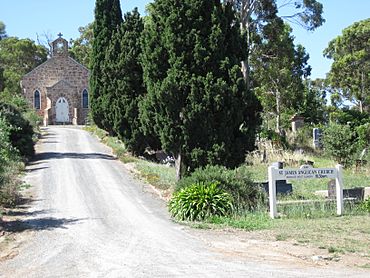Blakiston, South Australia facts for kids
Quick facts for kids BlakistonSouth Australia |
|||||||||||||||
|---|---|---|---|---|---|---|---|---|---|---|---|---|---|---|---|

St James' Church
|
|||||||||||||||
| Established | 1839 (town) 2003 (locality) |
||||||||||||||
| Postcode(s) | 5250 | ||||||||||||||
| Time zone | ACST (UTC+9:30) | ||||||||||||||
| • Summer (DST) | ACST (UTC+10:30) | ||||||||||||||
| Location |
|
||||||||||||||
| LGA(s) | District Council of Mount Barker | ||||||||||||||
| Region | Adelaide Hills | ||||||||||||||
| County | Hindmarsh | ||||||||||||||
| State electorate(s) | Kavel | ||||||||||||||
| Federal Division(s) | Mayo | ||||||||||||||
|
|||||||||||||||
| Footnotes | Adjoining localities | ||||||||||||||
Blakiston is a small town in the Australian state of South Australia. It's about 36 kilometers (22 miles) south-east of Adelaide, which is the capital city of South Australia. You'll find it right next to the Princes Highway.
Even though Blakiston has its own postcode (5250), it doesn't have its own post office. Mail for Blakiston is delivered through the nearby town of Littlehampton, which uses the same postcode. The town and the land around it cover about 16 square kilometers (6 square miles). This area has a mix of farmland and eucalypt forests. In 2021, about 377 people lived in Blakiston.
It can be hard to tell where Blakiston ends and Littlehampton begins. This is because new houses are being built, making the two towns seem like one.
Contents
A Look Back at Blakiston's History
Blakiston has been home to European settlers since 1846. The town was started by a man named Francis Davison. He named it after his family's old home, Blakiston Hall, which is in County Durham in England. For a few years, people spelled the town's name in different ways, but by 1850, everyone agreed on "Blakiston."
Important Buildings in Blakiston
Blakiston has several interesting old buildings. These include:
- A building that used to be a pub and a place for stagecoaches to stop. Today, it's a private home.
- A cheese factory that has been turned into a private house.
- St James Church and the house next to it, called the rectory.
- A school house that was once torn down but has since been rebuilt.
- A large house called Blakiston House, and a smaller house nearby.
Many of these buildings were built in the mid to late 1800s. They are made from a mix of pink sandstone and red brick. There are also a few other houses from the mid-1900s.
St James Church: A Historic Place of Worship
St James Church of England is one of the oldest Anglican churches in South Australia. It's the fifth oldest, to be exact! The church, its cemetery, and the rectory (the house for the church leader) are on a piece of land that is about 10 acres (4 hectares). This land was bought in 1843 and given for the church in 1846.
The rectory was finished in late 1846, and the church building was ready the next year. The church was officially opened and blessed on April 28, 1848.
The church is built from sandstone. Inside, you'll find pretty stained glass windows, old wooden pews, and a small organ. On one of the lower walls, there are small carvings of sailing ships. These carvings might be from the mid-1800s. Next to the church, there's a small bell tower that was added later. As of 2008, the church and its cemetery are still used. The rectory and the land around it are rented out by the church to people who live there.
In 1980, St James Church was listed on the Register of the National Estate. This means it was recognized as an important historical place in Australia.
The Rectory: A Home with a History
The rectory is a single-story building made of sandstone. It was built around the same time as the church. It has six main rooms, including a dining room, a study, a bedroom, a living room, and an old kitchen that isn't used anymore. There's also another small room whose original purpose isn't known.
In the early 1900s, a new part was added to the house. This addition now holds the kitchen and breakfast room, and a bathroom. The house also has an old, unused cellar underground. The roof of the rectory is made of corrugated iron, but underneath it, there's an original roof made of wooden shingles. Even though you can't see the shingle roof, people believe it's still in great condition.
Some people who used to live in the rectory have said they saw a ghostly figure in the study. They describe it as an old man quietly reading.
Behind the rectory, there used to be a barn made of sandstone. It had three walls, an earth floor, and a corrugated iron roof. One of its walls fell down in the early 1980s and was replaced poorly. The barn has since been completely taken down. There's also a small brick outhouse nearby.
Images for kids



